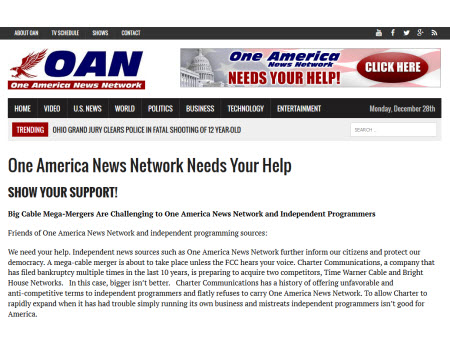One America News Doubles Down in Efforts to Leverage a Charter Pact

One America News Network’s effort to use the government’s merger review of Charter Communications’s purchase of Time Warner Cable to leverage carriage on Charter has gone into hyperdrive, with a little help from an agency process that does not weed out duplicative comments.
A check of the Federal Communications Commission’s comment docket on the deal reveals page after page of people saying the merger should be nixed unless it includes a carriage deal for OANN, or otherwise professing their love for the channel. In fact, at press time the docket had more than 44,000 comments in the last 30 days — more by a factor of 30 than the next most populous proceeding (special access rates at 1,387), fueled in part by the OANN fan club.
But if anyone tries to use the total number of OANN comments as argument for a groundswell of input, it will need to be with a grain or two of salt added. The docket contains numerous double, triple, and in some cases quintuple and sextuple postings of the same comments from the same people, so a total of those pro-OANN carriage comments would not be an accurate gauge.
A top FCC spokesperson signaled the agency takes that mirroring factor into account when vetting the docket. “As with all proceedings, the commission values public participation and takes a careful look at the feedback it receives,” FCC press secretary Kim Hart told The Wire. “In fully assessing the record, commission staff analyzes substantive arguments and accounts for comment patterns and anomalies.”
OANN parent Herring Networks initially praised Charter’s treatment of its networks and independent networks in general, but has since changed its tune, citing the hot-button issue of over-the-top carriage.
Charter does not carry OANN, which Herring has pointedly pointed out to the FCC, saying it was an example of Charter’s unfriendliness to independent networks. But OANN is also not carried by Comcast, Time Warner Cable, Cox or most other major MVPDs — with the exception of Verizon Communications’s FiOS TV and AT&T’s U-verse TV.
Vyve Pulls Surprise On ‘Spirited’ Artist Who Wins Contest
Multichannel Newsletter
The smarter way to stay on top of the multichannel video marketplace. Sign up below.
Vyve Broadband cooked up a fun surprise for 11-year-old Alexander Griffin, who’d entered Vyve’s first Christmas Card Art Contest. System manager Lloyd Walker, wearing a yellow Santa hat, made a surprise announcement at a Dec. 10 assembly at Griffin’s Forge Ridge Elementary School in Harrogate, Tenn., that the fifth grader had won the contest.
Griffin received a gift bag of prizes including an iPad Mini. The school got a check for $200 for art supplies. Students at the school were treated to cookies from a local bakery and hot chocolate. And Vyve partnered with Hallmark to use the artwork as the basis of its Christmas card this year.
More than 500 students in the nine states where Vyve operates submitted images of “The Spirit of Christmas.” Vyve’s New York-based ad agency selected the winner among seven finalists.
Auction Accounting: Who’s Got the Money?
Because The Wire loves arcana, here is some.
The Senate Commerce Committee quietly passed a bill (S. 2319, for fellow arcanians) that made a slight tweak to the Communications Act of 1934 and its 1996 update.
According to a committee staffer familiar with the bill’s progression, Sen. John Thune (R-S.D.) conferred with the Federal Communications Commission before offering up S. 2319 — it passed the subcommittee unanimously in a wink on Dec. 9 — that would change the way the agency deposits upfront payments from spectrum auction participants.
Payments include those from wireless companies that bid $40 billion-plus in the AWS-3 auction and are expected to bid in the broadcast incentive auction.
The FCC has been putting those payments in an interest-bearing account before turning them over to the Treasury. The interest went to the Telecommunications Development Fund. But the cost of administering that interstitial financial step did not justify continuing it, given how low interests rates are.
Up-front payments from the upcoming incentive auction will now go directly to the Treasury. Some of it will cover buyout bids to broadcasters or moving expenses for stations and cable operators, some of whom will have to retune headends to pick up the repacked TV stations after the auction.
The payments can be in the billions in aggregate. For example, a wireless company that wanted to bid on spectrum blocks in New York and Los Angeles would have to put up more than $1 billion just to be eligible to bid.
Contributing editor John Eggerton has been an editor and/or writer on media regulation, legislation and policy for over four decades, including covering the FCC, FTC, Congress, the major media trade associations, and the federal courts. In addition to Multichannel News and Broadcasting + Cable, his work has appeared in Radio World, TV Technology, TV Fax, This Week in Consumer Electronics, Variety and the Encyclopedia Britannica.

